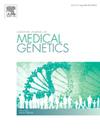Paracentric inversion disrupting the SHANK2 gene
IF 1.7
4区 医学
Q3 GENETICS & HEREDITY
引用次数: 0
Abstract
In this study, we employed a multifaceted approach combining short-read whole genome sequencing (WGS) analyzed using Delly, cytogenomics using Bionano technology, and Sanger sequencing to identify the breakpoints of a balanced de novo paracentric inversion on chromosome 11, spanning approximately 64 Mb (inv11q13.3; q25). This inversion was discovered in a girl who presented with mild intellectual disability (ID), speech and language delays, a delay in motor development and attention deficit hyperactivity disorder (ADHD). Detailed analysis of the breakpoints revealed the disruption of two genes; SHANK2, which is critical for encoding a postsynaptic scaffolding protein at glutamatergic synapses in the brain, and LINC02714, a long non-coding RNA (lncRNA). Although SHANK2 is not listed in the OMIM database as a causative gene to this date, literature reports at least 21 cases where (likely) pathogenic variants in SHANK2 have been identified in patients with neurodevelopmental disorders (NDDs). A loss of function variant of the SHANK2 gene is in line with the clinical presentation of this patient. No additional genetic variants that could explain her phenotype were identified. In conclusion, by combining WGS, cytogenomics and Sanger sequencing techniques, we identified the exact breakpoints of a large inversion providing a likely molecular diagnosis for our patient.
顺中心倒置破坏SHANK2基因。
在这项研究中,我们采用了多方面的方法,结合使用Delly分析的短读全基因组测序(WGS),使用Bionano技术的细胞基因组学和Sanger测序来确定11号染色体上平衡的从头倒位的断点,跨度约为64 Mb (inv11q13.3;q25)。这种倒置是在一个表现为轻度智力障碍(ID)、言语和语言迟缓、运动发育迟缓和注意缺陷多动障碍(ADHD)的女孩身上发现的。对断点的详细分析揭示了两个基因的断裂;SHANK2和LINC02714是一种长链非编码RNA (lncRNA),前者对编码大脑谷氨酸能突触中的突触后支架蛋白至关重要。尽管到目前为止,尚k2尚未在OMIM数据库中列为致病基因,但文献报道至少有21例神经发育障碍(ndd)患者中发现了尚k2(可能的)致病变异。SHANK2基因的功能缺失变体符合该患者的临床表现。没有其他基因变异可以解释她的表型。总之,通过结合WGS、细胞基因组学和Sanger测序技术,我们确定了一个大反转的确切断点,为我们的患者提供了可能的分子诊断。
本文章由计算机程序翻译,如有差异,请以英文原文为准。
求助全文
约1分钟内获得全文
求助全文
来源期刊
CiteScore
4.10
自引率
0.00%
发文量
193
审稿时长
66 days
期刊介绍:
The European Journal of Medical Genetics (EJMG) is a peer-reviewed journal that publishes articles in English on various aspects of human and medical genetics and of the genetics of experimental models.
Original clinical and experimental research articles, short clinical reports, review articles and letters to the editor are welcome on topics such as :
• Dysmorphology and syndrome delineation
• Molecular genetics and molecular cytogenetics of inherited disorders
• Clinical applications of genomics and nextgen sequencing technologies
• Syndromal cancer genetics
• Behavioral genetics
• Community genetics
• Fetal pathology and prenatal diagnosis
• Genetic counseling.

 求助内容:
求助内容: 应助结果提醒方式:
应助结果提醒方式:


